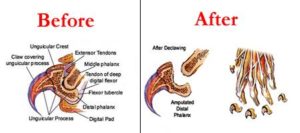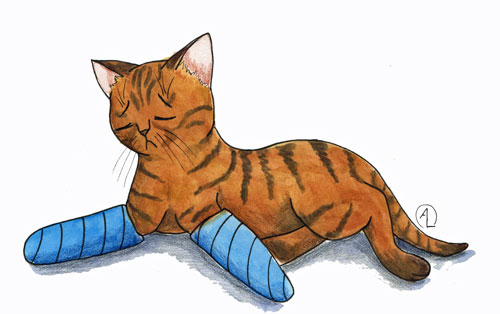When we talk about pets, cats are the most adored and loved of the category. There would be no one in this world who wouldn’t want to own a cute little kitten, or a fluffy cat, who keeps playing around the house, or keeps hopping from one corner to the other corner.
Maine coon cats are also the cats that are loved worldwide. Especially in USA, and in England, these cats are known to be one of the oldest of the breeds. The breeds are huge in size weighing 9 to 18 pounds. The male cats in this breed weigh more than females.They don’t grow to their full size until they reach three to five years of age.
Maine coons are good natured, and affable cats who love to play around.
They adapt to various environments and personality types. Connecting and getting friendly with people, they need a lovable relationship. If they like you enough, they would even keep following you around. Isn’t that cute?
Declawing felines is a candidly charged and fervent topic.
There are a few distinct methods and procedures of declawing a cat, however, they all include a certain something.The less you evacuate, the better, and that is the place the distinctions in procedures come in. The way felines are regularly declawed, you need to evacuate the hook, and you need to expel the little bit of bone that the paw develops from. In the event that you don’t, the hook will attempt to come back. There’s an instrument with a sliding edge, practically looks like executed, and it carves a straight line through the joint between that little bit of bone and the following bit of bone, which is much greater. When you do that, right underneath that is the cushion, and you really cut that directly down the middle as well. So it resembles cutting the tip of your finger off.
With corrective declawing, you utilize a modest bended cutting edge to go in and analyze out the hook and the minor bit of bone. The cushion is in place; all the delicate tissue is there. That is the thing that felines put their weight on. So the feline strolls serenely rapidly in light of the fact that its cushions are fine. At the point when the cushions are sliced down the middle, the feline can’t stroll on them without inconvenience. What’s more, they can’t stroll on them easily for quite a long time.
The vast majority of the agony originates from the injury to the delicate tissue. Be that as it may, restorative declawing is not a simple method to do: It’s tedious, so relatively few veterinarians do it.
Declawing is not at all a bad procedure, sometimes it’s actually needed.
Therapeutic Reasons – Sometimes, a paw is harmed, and it might be more secure and more accommodating to expel the hook inside and out. There is additionally the likelihood that a hook may contain a tumor or other ailment, in which case it is advantageous for the influenced zone to be evacuated.
Proprietor Distress – Some individuals essentially ought not to be presented to a feline’s paws. Individuals with smothered invulnerable frameworks, blood issue, and the elderly can’t generally manage a ripped at creature—not exclusively do the paws tear the skin if the feline scratches a man, however the paws have microscopic organisms on them that may affect certain people. Counsel both your restorative specialist and a veterinary expert at Avery Ranch Animal Hospital to talk about the therapeutic ramifications of a ripped at or declawed feline.
Restorative Reasons – The most widely recognized reason that individuals have their feline declawed is to keep the creature from tearing up cover or furniture. On the off chance that your feline doesn’t have paws, it can’t crush anything with them.
But most of the times it’s not considered a healthy procedure because:
Unnatural for Cat – The truth of the matter is, felines are conceived with hooks, and many see evacuating them as an interruption of nature’s request for the creature. Expelling a feline’s hooks successfully evacuates its barrier component, its method for getting and holding things, and so on.
Excruciating for Cat – Declawing is surgery, and surgery is difficult. Feline’s hooks dislike toenails; they resemble fingers, and evacuating them includes the cutting of tissue and bone. It is to a great degree repulsive for the feline, particularly when they need to stroll after the surgery.
Conceivable Complications – Infection is a probability in any surgery. Some of the time paws can even become back if the surgery isn’t performed accurately, despite the fact that they won’t become back appropriately, creating additional issues.
Remember this, a few people, regardless of the possibility that they are against declawing, would battle that it is better for a feline’s proprietor to declaw the creature then give it away or euthanize it. At Avery Ranch Animal Hospital, we suggest calling and examining the choices with your Avery Ranch veterinarian. Conversing with an expert will help you choose which choice is appropriate for you, your family, and your feline.
In some countries it is illegal to declaw.
The laws overseeing declawing feline’s strategies contrast from nation to nation furthermore from state to state inside similar nations. With regards to declawing felines UK, the methodology is unlawful and was banned by the Animal Welfare Act 2006. In it, “impedance with the delicate tissues or bone structure of the creature, generally than for the motivations behind its restorative treatment” is unequivocally disallowed [Source: Wikipedia.org].
The methodology is viewed as heartless and even before the demonstration declawing was still uncommon. Proficient direct however takes into consideration declawing where it is with the end goal of treating a harm or avoiding harm to the feline. Other than the United Kingdom, different nations in which declawing cats is just performed in extraordinary conditions include:
- England
- Scotland
- Wales
- Italy
- Australia
- Switzerland
- Norway
- Sweden
- Ireland
- Denmark
- Finland
- Slovenia
- Brazil
- Australia
There are several costs to declawing as well.
In case you have put your brain to it, a worry that is unavoidable regularly is; what amount does it cost to get a feline declawed? While looking for a healing center in which to have your pet declawed, a great deal will become an integral factor. Rather than giving a lot of thoughtfulness regarding the amount it is to declaw a feline, first consider the accompanying
- In the first place, build up if declawing felines is lawful to have declawing your feline declawed where you live. Indeed, even where it is legitimate, not all vets will offer the administration and along these lines you should do appropriate research.
- To what extent the vet has been completing the technique will decided their abilities. The more they have done it the better as it gives them significantly more experience and pertinent information in what they do.
- Other than this, contingent upon the establishment you pick, it is likely that the cost cited for the methodology will cover anesthesia, anti-toxins, torment prescription, a maybe a couple days doctor’s facility remain and also a post-surgical examination. This however does not mean you won’t experience other extra expenses previously.
- One more procedure of declawing the cat is laser declawing. With this strategy on the best way to declaw a feline, laser shafts are utilized rather than a surgical blade. Bones from which the paws develop are evacuated. This strategy accompanies the benefits of negligible if any draining and less torment.
- After the methodology has been completed, the feline will then begin to walk a couple of hours after the fact. At the point when the technique is done well and proper torment administration prescription is managed, a snappy recuperation is ensured. The feline ought to likewise eat and acknowledge petting effectively.
- To facilitate their use of the litter box, make utilization of un-popped popcorn pet hotels or destroyed paper. This will keep the feline safe and avoid intemperate torment. Never utilize sand in a litter for declawed felines as it could get into the recuperating paw which might be excruciating.
Like some other surgery, declawing felines includes some agony. Days after the declawing strategy, you may see the feline shaking their paw. This could be a result of torment or the irritation brought about by the sewing or paste.

So it’s now up to you to decide what procedure is appropriate for your cat and if you want to take the procedure of declawing or not. Your feline should be like family to you and it’s you who should decide what’s right for your family, and what’s not. Your family should be in no pain, by any cause.


